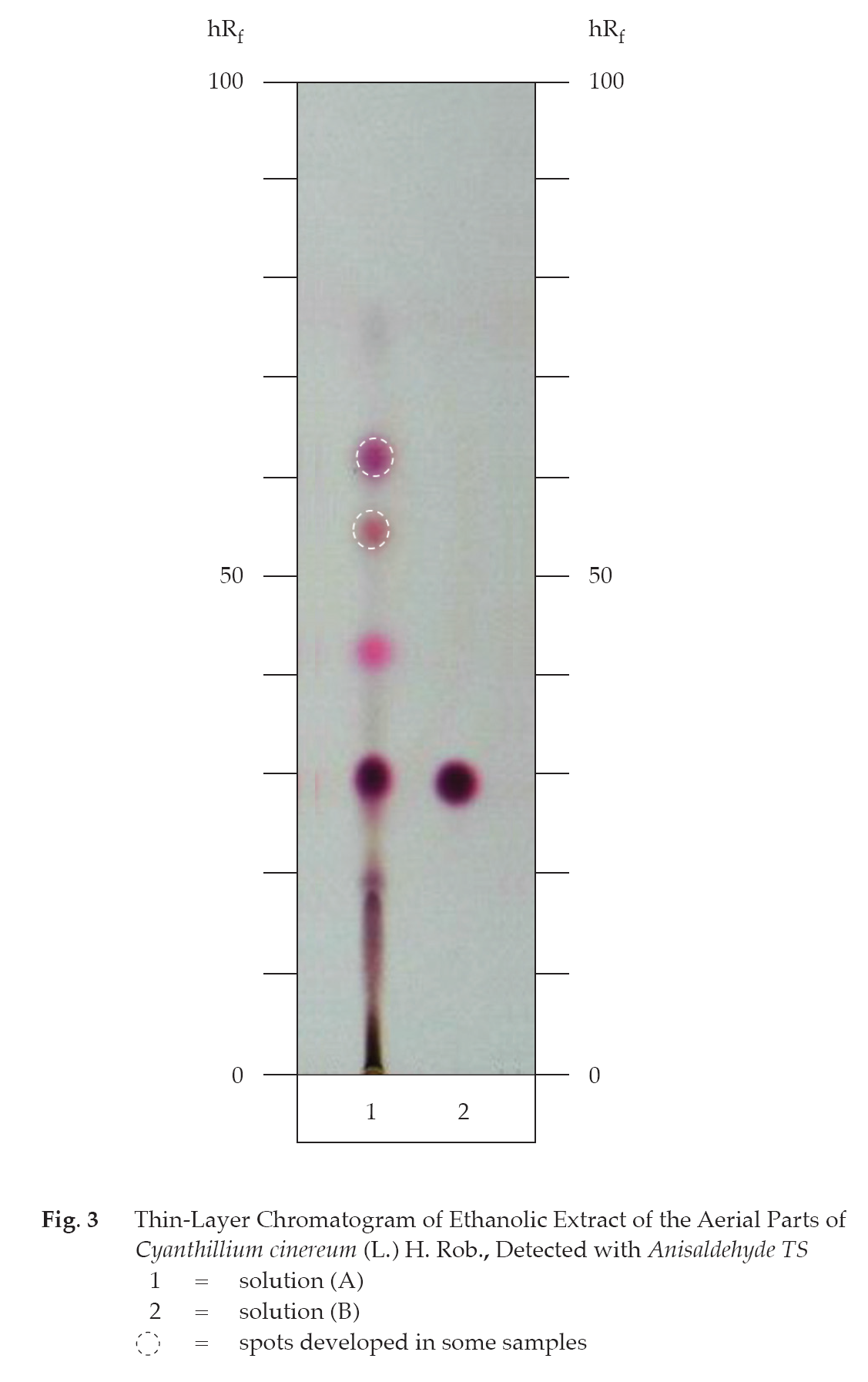ตำรามาตรฐานยาสมุนไพรไทย
Thai Herbal Pharmacopoeia
สำนักยาและวัตถุเสพติด กรมวิทยาศาสตร์การแพทย์ กระทรวงสาธารณสุข
Bureau of Drug and Narcotic, Department of Medical Sciences, Ministry of Public Health(Tinospora crispa (L.) Hook.f. & Thomson)
(Nelumbo nucifera Gaertn.)
(Centella asiatica (L.) Urb.)
(Centella Dry Extract)
(Centella Cream)
(Mesua ferrea L.)
(Piper sarmentosum Roxb.)
(Piper sarmentosum Roxb.)
(Pterocarpus santalinus L. f.)
(Santalum album L.)
(Senna tora (L.) Roxb.)
(Senna alata (L.) Roxb.)
(Senna Alata Tea)
(Piper retrofractum Vahl)
(Myristica fragrans Houtt)
(Andrographis paniculata (Burm. f.) Nees)
(Andrographis Capsules)
(Allium ascalonicum L.)
(Ocimum tenuiflorum L.)
(Curcuma longa L.)
(Turmeric Capsules)
(Turmeric Dry Extract)
(Turmeric Dry Extract Capsules)
(Arcangelisia flava (L.) Merr.)
(Curcuma sp.)
Harrisonia perforata (Blanco) Merr.
(Aristolochia pierrei Lecomte)
(Zingiber officinale Roscoe)
(Ginger Capsules)
(Ginger Tea)
(Cassia fistula L.)
(Nardostachys jatamansi (D. Don) DC.)
(Angelica sinensis (Oliv.) Diels)
Artemisia annua L.
(Ligusticum sinense Oliv. cv. Chuanxiong)
(Neopicrorhiza scrophulariiflora Pennell)
(Atractylodes lancea (Thunb.) DC.)
(Aucklandia lappa Decne)
(Terminalia chebula Retz.)
(Angelica dahurica (Hoffm.) Benth. & Hook. f. ex Franch. & Sav. var. dahurica)
(Kaempferia parviflora Wall. ex Baker)
(Hibiscus sabdariffa L.)
(Roselle Tea)
(Allium sativum L.)
(Zingiber zerumbet (L.) Sm.)
(Wurfbainia testacea (Ridl.) Škorničk.& A. D. Poulsen)
(Cannabis sativa L.)
(Myristica fragrans Houtt)
(Dracaena cochinchinensis (Lour.) S. C. Chen)
(Ficus racemosa L.)
(Hyptis suaveolens (L.) Poit.)
Clerodendrum indicum (L.) Kuntze
(Phyllanthus emblica L.)
(Citrus hystrix DC.)
(Citrus hystrix DC.)
(Areca catechu L.)
(Momordica charantia L.)
Moringa oleifera Lam.
(Aegle marmelos (L.) Corrêa)
(Solanum trilobatum L.)
(Morus alba L.)
Gynostemma pentaphyllum(Thunb.)
Makino
(Clinacanthus nutans (Burm. f.) Lindau)
(Cissus quadrangularis L.)
(Mimusops elengi L.)
(Zingiber montanum (J. König) Link. ex A. Dietr.)
(Piper betle L.)
(Capsicum annuum L.)
(Capsicum Oleoresin)
(Capsicum Gel)
(Piper nigrum L.)
(Piper nigrum L.)
(Eurycoma longifolia Jack)
(Thunbergia laurifolia Lindl.)
(Piper wallichii (Miq.) Hand.-Mazz.)
Senna garrettiana (Craib) H. S. Irwin & Barneby
(Terminalia bellirica (Gaertn.) Roxb.)
(Terminalia chebula Retz.)
(Caesalpinia bonduc (L.) H. Roxb.)
(Tarlmounia elliptica (DC.) H. Rob., S. C. Keeley, Skvaria & R. Chan)
(Hog Creeper Vine Dry Extract Capsiles)
(Hog Creeper Vine Dry Extract)
(Brachypterum scandens (Roxb.) Miq.)
(Lepidium sativum L.)
(Nigella sativa L.)
(Cuminum cyminum L.)
(Foeniculum vulgare Mill.)
(Plantago ovata Forssk.)
(Pimpinella anisum L.)
(Carum carvi L.)
(Anethum graveolens L.)
(Trachyspermum ammi (L.) Sprague)
Albizia procera (Roxb.) Benth.
(Acorus calamus L.)
(Tiliacora triandra (Colebr.) Diels)
Cyanthillium cinereum (L.) H. Rob.
(Orthosiphon aristatus (Blume) Miq.)
Murdannia loriformis (Hassk.) R. S. Rao & Kammathy
(Capparis micracantha DC.)
(Chrysopogon zizanioides (L.) Roberty)
(Cyperus rotundus L.)
(Cannabis sativa L.)
(Syzygium aromaticum (L.) Merr. & L. M. Perry)
(Boesenbergia rotunda (L.) Mansf.)
(Acanthus ebracteatus Vahl)
(Acanthus ilicifolius L.)
(Kaempferia galanga L.)
(Curcuma comosa Roxb.)
Betula alnoides Buch.-Ham. ex D. Don
Cannabis sativa L.
Carthamus tinctorius L
Mitragyna speciosa (Korth.) Havil
Mallotus repandus (Rottler) Müll. Arg
Azadirachta indica A. Juss. var. siamensis Valeton
Azadirachta indica A. Juss. var. siamensis Valeton
Punica granatum L.
Rhinacanthus nasutus (L.) Kurz
Baliospermum solanifolium (Burm.) Suresh
Curcuma aeruginosa Roxb
Boesenbergia kingii Mood & L. M. Prince
Senegalia rugata (Lam.) Britton & Rose
Acacia concinna (Willd.) DC.
Senegalia rugata (Lam.) Britton & Rose
Acacia concinna (Willd.) DC.
Senna alexandriana Mill. var. alexandriana
Cassia acutifolia Delile, Cassia angustifolia Vahl
Butea superba Roxb. ex Willd.
[Plaso superba (Roxb. ex Willd.) Kuntze, Rudolphia superba (Roxb. ex Willd.) Poir.
Pueraria candollei Graham
ex Benth. var. mirifica (Airy Shaw & Suvat.) Niyomdham
Streblus asper Lour.
Suregada multiflora (A. Juss.) Baill. (Gelonium
multiflorum A. Juss.
Plumbago zeylanica L.
Plumbago indica L.
Biancaea sappan (L.) Tod.
Ziziphus attopensis Pierre
Streblus asper Lour.
Justicia gendarussa Burm. f.
Enhalus acoroides (L. f.) Royle
Bridelia ovata Decne.
Tamarindus indica L.
Citrus × aurantiifolia (Christm.) Swingle
Garcinia mangostana L.
Blumea balsamifera (L.) DC
Persicaria odorata (Lour.) Soják
Zingiber montanum (J. König) Link ex A. Dietr.
Mammea siamensis (Miq.) T. Anderson
Citrus maxima (Burm.) Merr.
Citrus × aurantium L. ‘Som Sa’
Punica granatum L.
Rhinacanthus nasutus (L.) Kurz
Little Ironweed Herb is the dried aerial part of Cyanthillium cinereum (L.) H. Rob. [Conyza cinerea L., Vernonia cinerea (L.) Less.] (Family Compositae), Herbarium Specimen Number: DMSC 5258, Crude Drug Number: DMSc 1171.
Constituents Little Ironweed Herb contains triterpenoids (e.g., lupeol), flavonoids and sesquiterpene lactones (e.g., hirsutinolides, vercinolides). It also contains nicotine, nitrates, nitrites, potassium salts, sterols, etc.
Description of the plant (Fig. 1) Herb, annual to perennial, up to 1 m tall; stem erect, conspicuously ribbed, pubescent. Leaves simple, spirally arranged, lanceolate or ovate to broadly ovate, 3.5 to 6.5(–10) cm long, 1.5 to 3 cm wide, upper leaves gradually smaller, apex acute to acuminate or obtuse, base cuneate or attenuate, margin serrate or undulateserrulate, upper surface puberulous, lower surface greyish pubescent to tomentose, especially on nerves, glandular, lateral veins 5 to 7 pairs; petiole 1 to 2.5 cm long, often winged. Inflorescence terminal and axillary, broadly paniculate; capitulum campanulate, 5 to 8 mm long; peduncle 0.3 to 1 cm long; involucres campanulate, 4 to 5 mm long, 2.5 to 3 mm wide; phyllaris green with purple apex, 3- to 4-seriate, imbricate, linear to oblong or lanceolate, 1.5 to 2 mm long, apex acute to acuminate, outer surface sericeous glandular. Florets 25 to 30; corolla pink to purple, rarely white, funnel-form, 4.5 to 6 mm long, puberulous, glandular, basal tube 3 to 3.5 mm long, lobes 5, 1 to 2 mm long; anther short, apical appendage acute, base obtuse; style purple, about 3 mm long, 2-branched, branches about 0.5 mm long, inner surface with stigmatic papillae, outer surface with sweeping hairs. Fruit achene, clavate, 1.5 to 2 mm long, about 0.7 mm wide, densely hairs and glandular dotted; pappus bristles, whitish, 2-seriate, 3 to 5 mm long, persistent.
Description Odour, characteristic; taste, mild.
Macroscopical (Fig. 1) A mixture of broken, crisp, cylindrical, ribbed stems, flowering heads, whitish fruiting heads with bristled pappi, and broken dark-green lanceolate to broadly ovate leaves.
Microscopical (Figs. 2a, 2b, 2c, 2d) Transverse sections of the leaf through the midrib and lamina show upper epidermis, mesophyll, vascular bundle, and lower epidermis. Upper epidermis: a layer of rectangular cells; stomata; trichomes, multicellular uniseriate and T-shaped. Mesophyll: palisade cells, a layer of columnar cells, some containing oil droplets and/or rosette aggregate crystals; spongy cells, irregularly shaped, thin-walled, some containing oil droplets; collenchyma, angular and lamellar, in the upper and lower parts of midrib. Vascular bundle: xylem in the upper part and phloem in the upper and lower parts. Lower epidermis: small rectangular cells; stomata; trichomes, T-shaped, multicellular uniseriate and glandular.
In surface view, upper epidermis of the lamina shows slightly wavy-walled cells, anomocytic stomata, T-shaped and multicellular uniseriate trichomes; lower epidermis illustrates wavy-walled cells, anomocytic stomata, T-shaped, multicellular uniseriate and glandular trichomes.

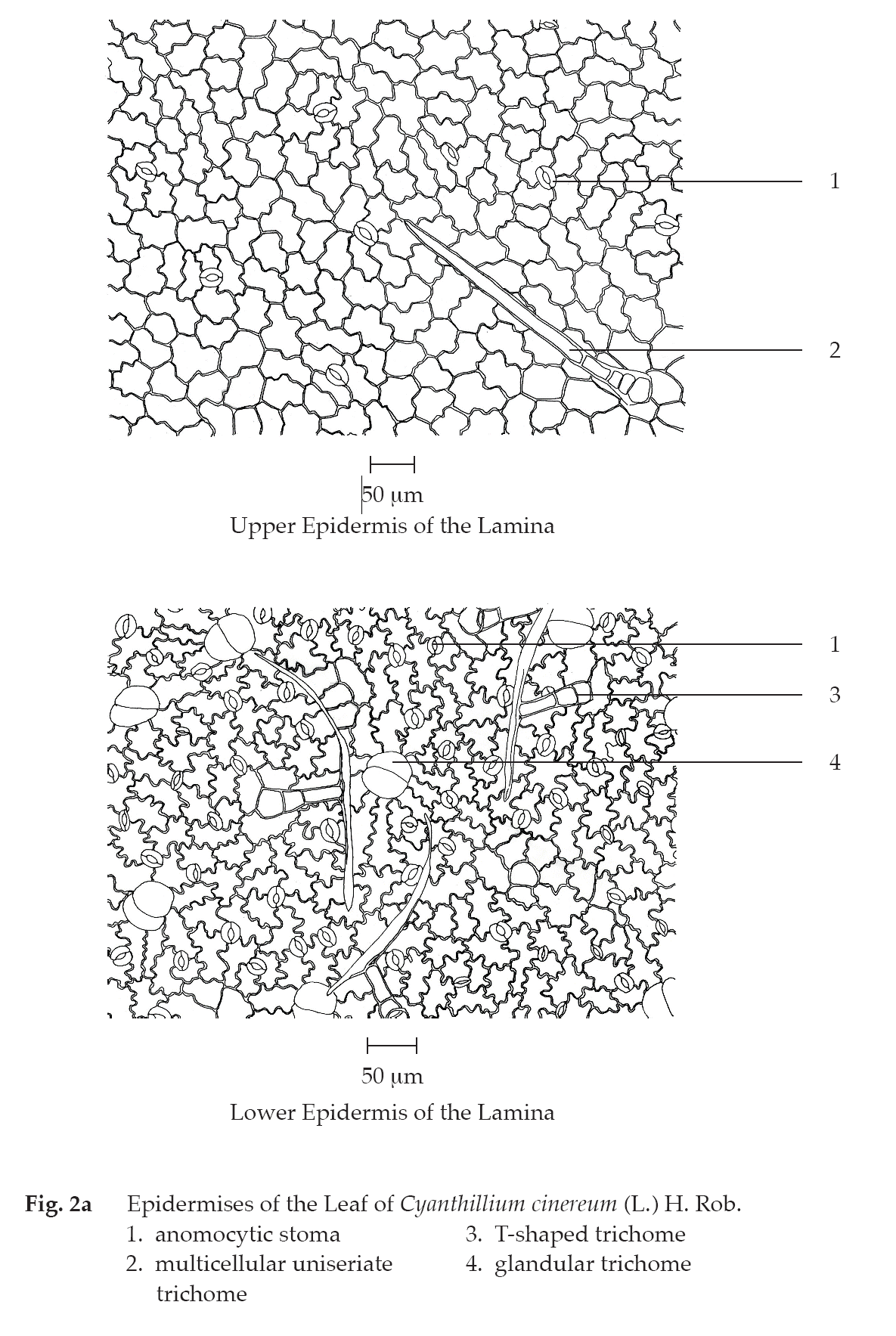
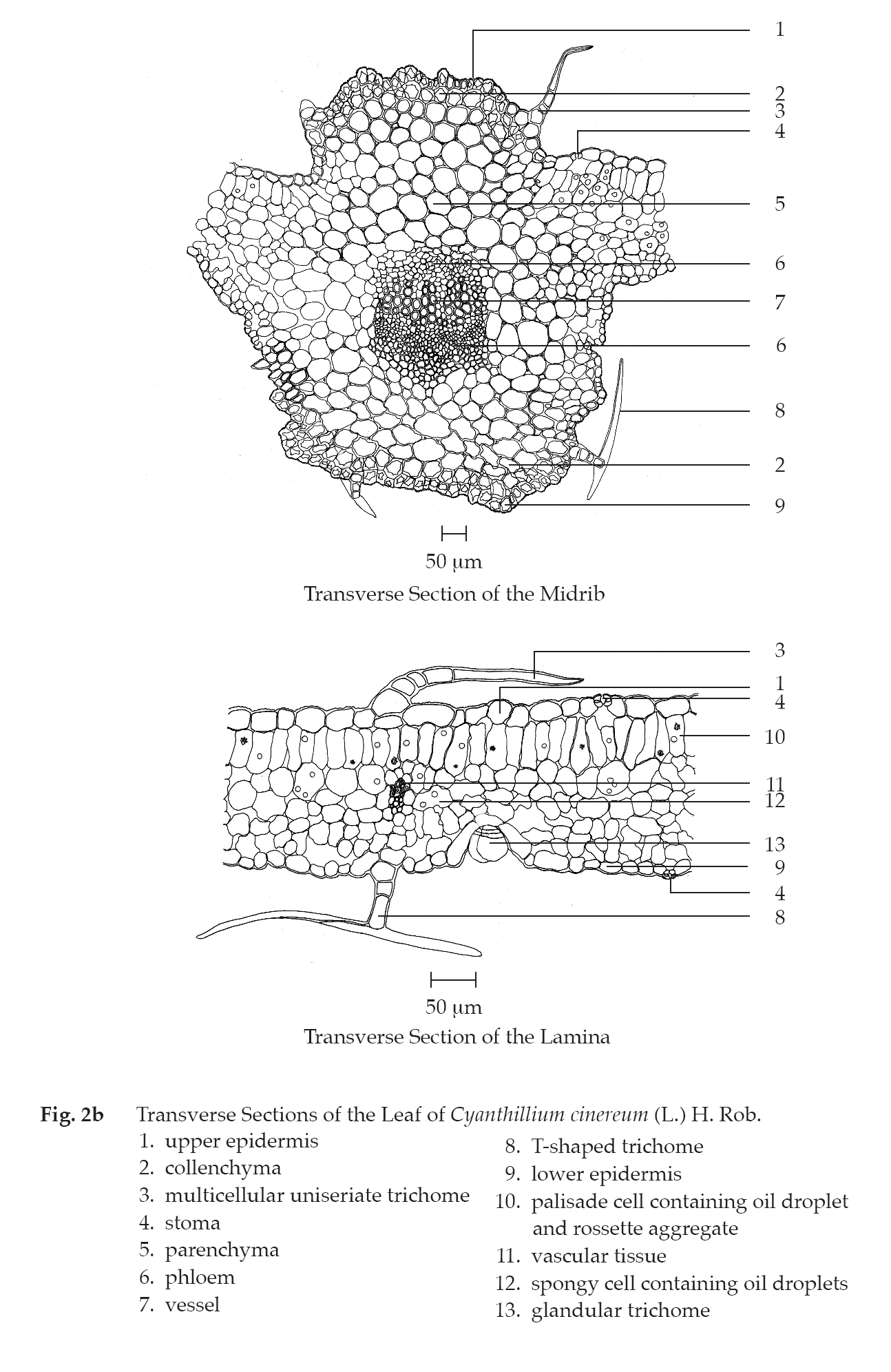
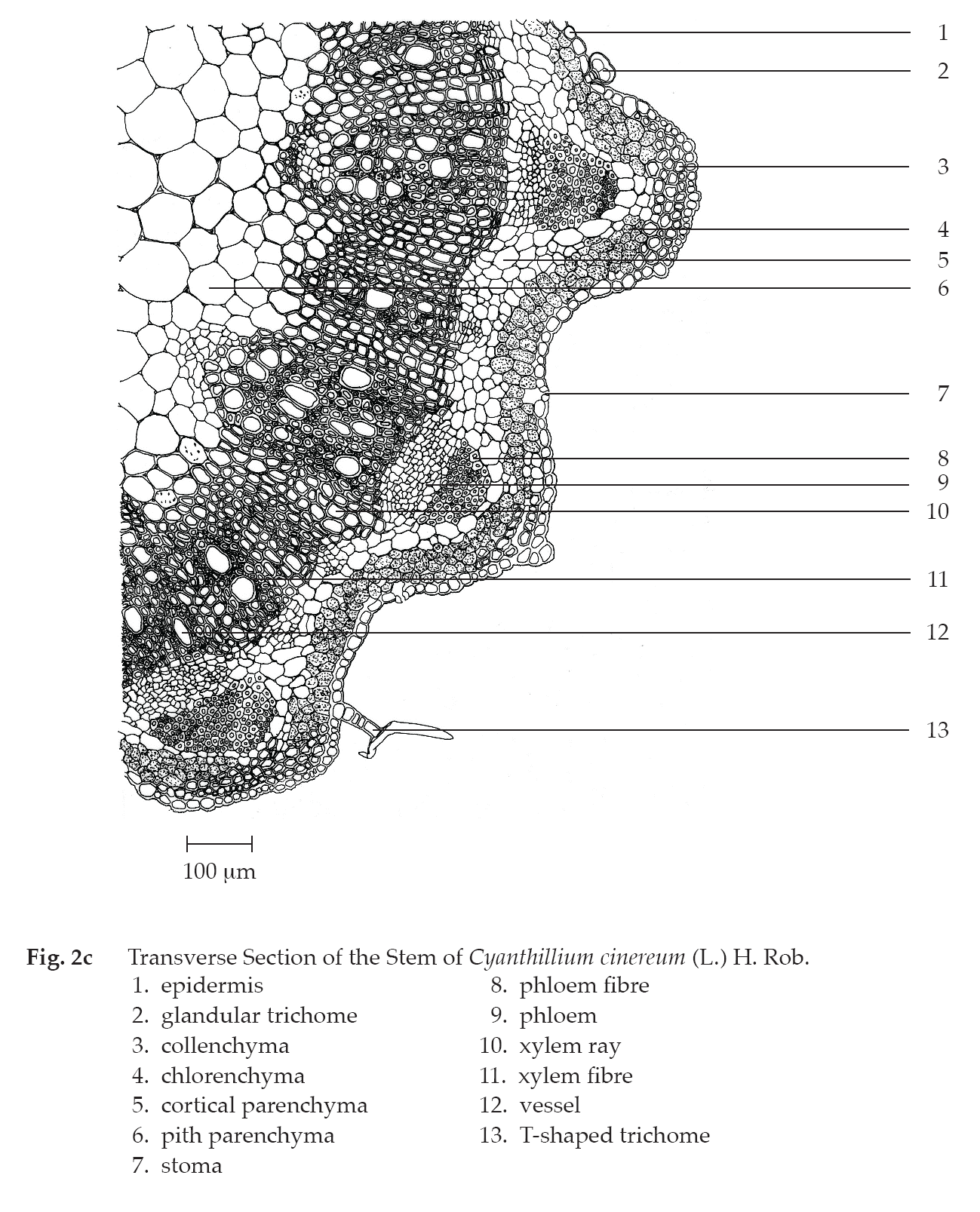
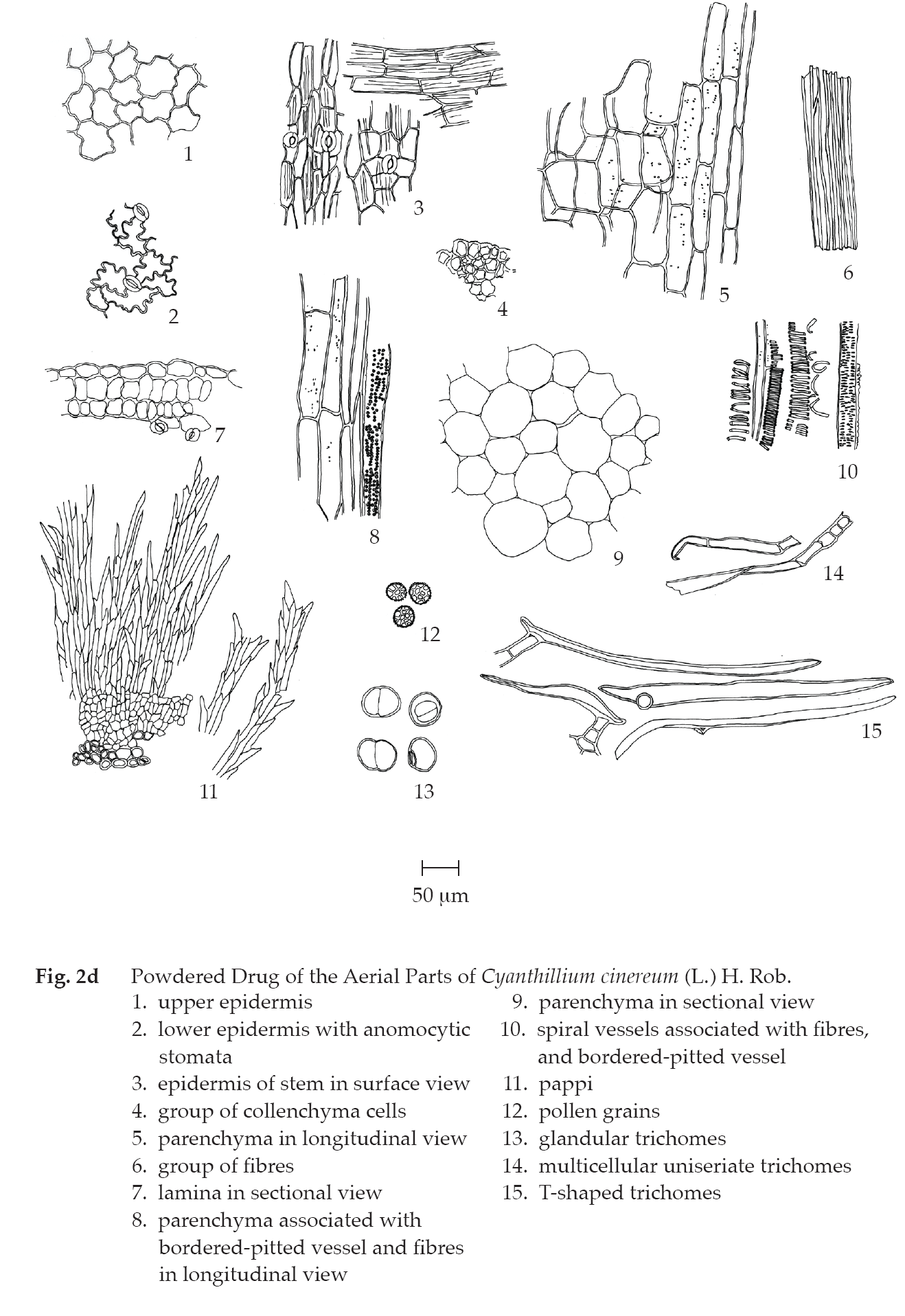
Transverse section of the stem shows epidermis, cortex, vascular tissue, and pith. Epidermis: a layer of round cells; trichomes, T-shaped, multicellular uniseriate and glandular. Cortex: layers of lamellar collenchyma cells, round parenchyma and groups of fibres in the mature stem. Vascular tissue: phloem, group of fibres and parenchyma; xylem, rays, fibres and vessels. Pith: numerous large round parenchyma.
Little Ironweed Herb in powder possesses the diagnostic microscopical characters of the unground drug. T-shaped trichomes, pappi and anomocytic stomata are frequently observed and characteristic.
Packaging and storage Little Ironweed Herb shall be kept in well-closed containers, protected from light, and stored in a dry place.
Warning It should be used with caution in patients with impaired cardiac and/or renal function.
Identification
A. Boil 1 g of the sample in coarse powder, with 20 mL of water for 1 to 2 minutes and filter (solution 1). To 1 mL of solution 1, add 1 or 2 pieces of magnesium ribbon and a few drops of hydrochloric acid: a pinkish red colour is produced.
B. To 1 mL of solution 1, add a few drops of iron(III) chloride TS and shake well: a greenish brown colour is produced.
C. Carry out the test as described in the “Thin-Layer Chromatography” (Appendix 3.1), using silica gel F254 as the coating substance and a mixture of 57 volumes of n-hexane and 3 volumes of ethyl acetate as the mobile phase and allowing the solvent front to ascend 12 cm above the line of application. Apply separately to the plate, 5 µL of solution (A) and 2 µL of solution (B). Prepare solution (A) by refluxing 1 g of the sample, in fine powder, with 20 mL of ethanol for 30 minutes and filtering. Evaporate the filtrate to dryness under reduced pressure at 30º and dissolve the residue in 2 mL of ethanol. For solution (B) dissolve 3 mg of lupeol in 1 mL of methanol. After removal of the plate, allow it to dry in air and spray the plate with anisaldehyde TS and heat at 105º for 5 minutes. The chromatogram obtained from solution (A) shows a purple spot (hRf value 28 to 30) corresponding to the lupeol spot from solution (B). Other pink spots are observed (Table 1); see also Fig. 3.
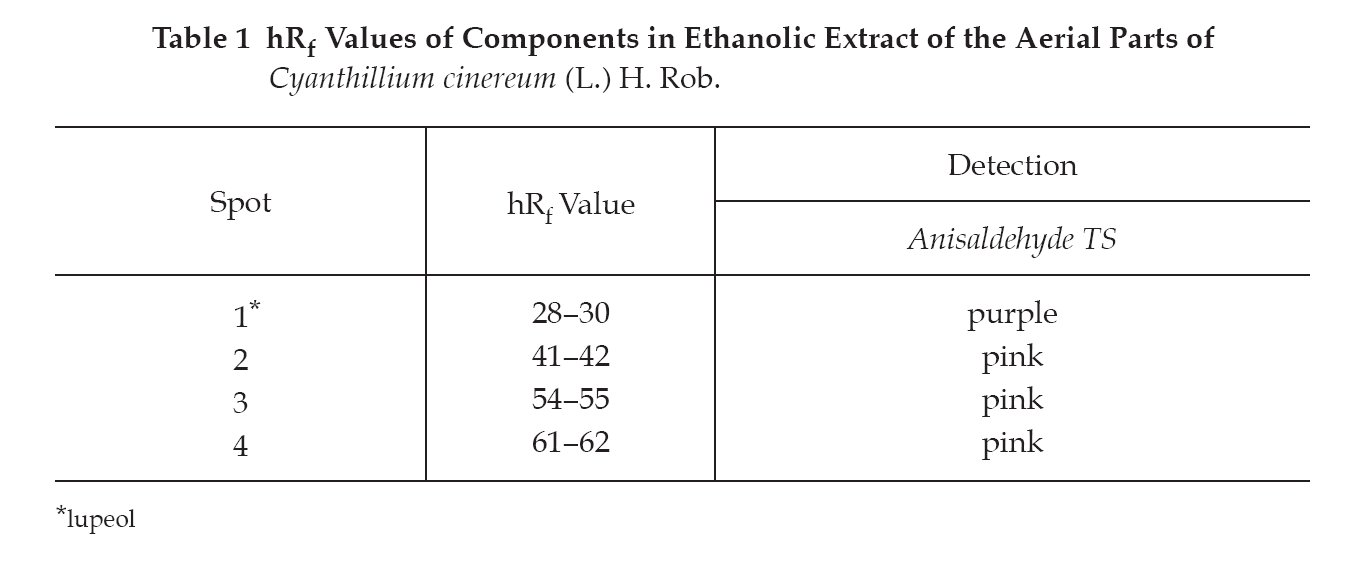
Loss on drying Not more than 9.0 per cent w/w after drying at 105º to constant weight (Appendix 4.15).
Foreign matter Not more than 2.0 per cent w/w (Appendix 7.2).
Acid-insoluble ash Not more than 3.0 per cent w/w (Appendix 7.6).
Total ash Not more than 13.0 per cent w/w (Appendix 7.7).
Ethanol-soluble extractive Not less than 7.0 per cent w/w (Appendix 7.12).
Water-soluble extractive Not less than 13.0 per cent w/w (Appendix 7.12).
Dose 2 g, prepared as an infusion by soaking in 120 to 200 mL of boiling water, three or four times a day after meals.
